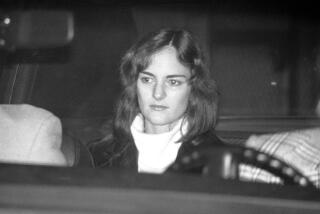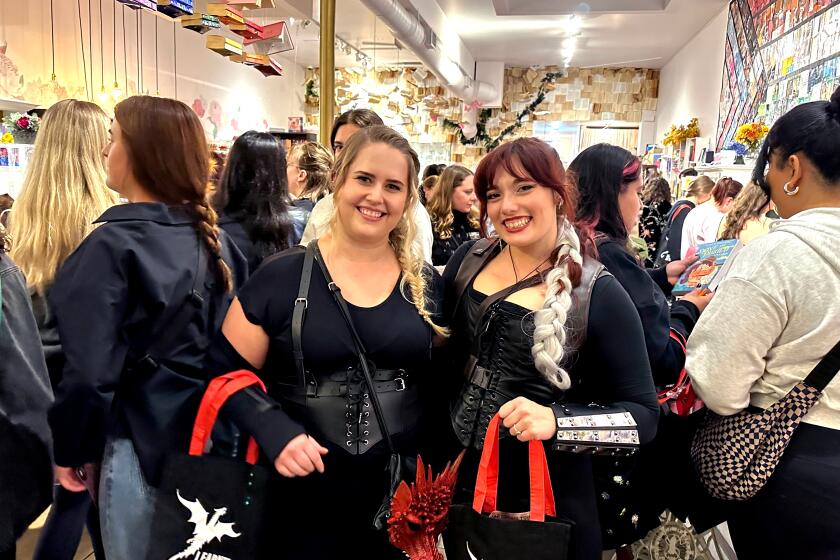Hurston: The world stands corrected
- Share via
The pop-culture version of Zora Neale Hurston’s life is bleak with tragedy, her final days reduced to a freeze-frame image of her dive from literary grace. True, in the years before she died at 69 in Florida, Hurston was living in poverty and, at one point, forced to work as a maid. Hurston, a larger-than-life writer who ran with Langston Hughes, a two-time Guggenheim fellow who had a brief flirtation with Hollywood, had been forgotten; all her books were out of print. A cloud of pathos shrouded her legacy in 1960, after she was buried in that place of ineffable sadness, an unmarked grave.
These days, the pathos sometimes overshadows her work. But two major books on Hurston -- the first in 25 years -- are painting a fuller portrait of the writer’s enigmatic life.
Hurston was complex, despite the facile, heart-tugging assumptions about her life, insists USC English professor Carla Kaplan, editor of the recently released biography and collection of letters “Zora Neale Hurston” (Doubleday). It’s not true, for instance, that Hurston was alone at the end, that she died in a county welfare home or was relegated to a lonely pauper’s funeral, Kaplan said. Such lore has been perpetuated amid Hurston’s emergence as a figure who is “well on her way to becoming our next Frida Kahlo in an American context,” she noted.
Hurston was the most published African American woman of her time. She was known as a folklorist, essayist, playwright and anthropologist, and for her 1937 novel, “Their Eyes Were Watching God,” a classic story of a woman’s self-discovery. Her writing captured “the Negro farthest down,” in places such as juke joints and the mule camps of Alabama, or in Jamaica, where she met the descendants of escaped slaves.
In the mid-’70s, writer Alice Walker helped spark a renaissance of interest in Hurston. Her image now sells calendars and coffee mugs and, earlier this year, was released on a U.S. postage stamp. This summer, production is scheduled to begin on an “Oprah Winfrey Presents” TV movie based on “Their Eyes Were Watching God.” Halle Berry has signed to star in the racy love story.
“It’s wonderful,” Kaplan said of the exposure, “but the downside, the risk of that, is a commercialization of her that fails to understand again who she was.... Even as we feel the tragedy of her life, it’s easy to romanticize away pieces of the reality.”
Kaplan’s book, along with the new biography “Wrapped in Rainbows” (Scribner) by Valerie Boyd, builds on the work of Hurston’s first major biographer, Robert E. Hemenway. Hemenway’s initial research for “Zora Neale Hurston,” published in 1977, inspired Walker to search for Hurston’s unmarked grave in Fort Pierce, on the east coast of Florida, and buy it a marker. Walker wrote about her quest for Ms. magazine in 1975, helping to touch off the revival of interest in the writer, whose seven books now are back in print.
Boyd, arts editor at the Atlanta Journal-Constitution newspaper, heard Hemenway speak about his biography in 1994. Hemenway was saying it was time for a new book on Hurston, preferably written by an African American woman because “he thought there were things he missed because he was a white man,” Boyd said.
“I’m writing from the inside out,” she continued. “My goal was to help the reader see what it was like to be Zora Neale Hurston ... be inside her skin. I wanted to paint an intimate portrait of her life, where I think his biography was an academic look at her life. There was some distance there.”
“Wrapped in Rainbows,” for instance, examines Hurston’s sexuality and details her struggle to make a living as a writer. Boyd is speaking to groups around the country about Hurston.
Hurston finally is being accorded the recognition she deserves, said Hemenway, now chancellor of the University of Kansas. Hemenway, who wrote the foreword for Kaplan’s book, is happy to see Hurston back in the public eye, but “the danger is, whenever a writer becomes iconic ... you lose the true history of the writer and the history of the imagination of the writer. The thing I feel so positive about is we’ve got two brand-new books that give you the true Hurston, who sometimes takes positions that don’t make everyone comfortable but who lived a life of imagination and who’s a writer that teaches us a lot about our culture.”
Forever a paradox
Hurston was a whiskey-slamming party lover, charismatic and difficult, who sometimes drew fire for her political views, like the time she criticized the U.S. Supreme Court’s ruling in the landmark school desegregation case Brown vs. Board of Education in 1954. It’s not that Hurston favored segregated schools, Kaplan pointed out. But Hurston considered the decision condescending, writing to a friend: “I actually do feel insulted when a certain type of white person hastens to effuse to me how noble they are to grant me their presence.”
She was paradoxical from the moment she blazed her way onto the scene of the Harlem Renaissance, a coterie of African American artists in the 1920s that included Hughes, Dorothy West and James Weldon Johnson. Educated at Barnard College and Howard University, Hurston began writing poems and magazine articles in the ‘20s. Beginning in 1925, she also worked with anthropologist Franz Boas and, in the mid-’30s, with folklorist Alan Lomax. In 1941, she moved to Los Angeles and spent three months working as a consultant to Paramount Pictures.
Hurston was an iconoclast who became a folklorist “at a point when really the whole agenda was about documenting urban middle-class black culture,” Kaplan said. “That’s where people thought they could make a difference, show white society, ‘Look, we’re no different.’ What’s she doing? She’s showing white society how different blacks are.”
Hurston, ever the storyteller, also was known for crafting her own public image. Throughout her life, for instance, she lied about her age, partly, perhaps, so other members of the Harlem Renaissance wouldn’t think that, in her mid-30s, she was too old to hang out with them. Hurston, who had three failed marriages, came across as brazen, but her letters reveal her vulnerable side, Kaplan said.
“The thing that became most salient to me in the letters is how, through her entire life, she was constantly looking for somebody who would understand her, and who she felt she could trust,” Kaplan said. “The letters she writes to the people who gave her that leap off the page with a kind of relief and joyousness, and all the other letters have a kind of a longing or sadness.”
Hurston wrote painfully obsequious letters to white patrons who supported her. In one letter, for instance, she addressed the patron as “Darling, my God-Flower,” and she signed another: “Your humble and obedient little ‘pick,’ ” or pickaninny. (Letters to friends glowed with affection: “A flock of purple rabbits to you,” for instance. And “Love and 10,000 little squaddly toad frogs.”)
Her sense of humor emerged in a letter she wrote to the secretary of a patron, thanking her for donated dresses. “I look very beautiful in the dresses and you will perhaps feel a tiny twinge of jealousy when you gaze upon me, but the artist in you will be so delighted at the sight of such a perfect union of clothes and woman that you will stifle your jealousy at once and rejoice with me.”
Her letters are intimate to friends such as photographer and writer Carl Van Vechten, one of the few whites associated with the Harlem Renaissance. “Dear Carl,” she wrote in 1934, “The pictures are swell! I love myself when I am laughing. And then again when I am looking mean and impressive ... you look like a red-hot spider man in the center of your web, looking for a sizzling fly. I like that.” To Hughes in 1931: “How dare you use the word ‘nigger’ to me. You know I don’t use such a nasty word. I’m a refined lady and such a word simply upsets my conglomeration.... Treat me refined.”
Kaplan’s book includes more than 600 letters, unearthed in university archives or the attics and basements of strangers who often didn’t even know that one of their relatives had corresponded with Hurston. She managed to hook up with Hurston’s friends near Fort Pierce, including retired Deputy Sheriff Patrick Duvall.
After Hurston’s death, Duvall happened to be driving by when he noticed a fire behind her house, Kaplan wrote in her book. A yardman, who had been told to clean the house, was burning Hurston’s papers and belongings. Duvall put out the fire and saved her papers. For two years, he stored them on his covered porch until he and a group of Hurston’s friends could find an archive to take the material. The papers now are at the University of Florida in Gainesville.
Over the decades, Duvall has watched with dismay the way Hurston has been reduced to a cliche. “Pat Duvall didn’t put out that fire and save her papers because he thought she was a nice lady,” Kaplan said. “He knew exactly who she was, and there were blacks all over the country in the 1950s who had never forgotten her.”
The lingering misconception is “that she was literally alone, and that would be to slight the black community she lived in,” Kaplan said.
Duvall and others told Kaplan that friends rallied around Hurston in 1959 after the writer had suffered a series of strokes. The community arranged to have people check on her regularly and deliver food so she could spend her last days at home. After her death, about 100 people showed up for a lovely funeral, which was paid for by friends and community members. Kaplan speculated that friends meant to take up a second collection later for a headstone and never got around to doing so.
At the end, Hurston was remembered by people she cared about, Kaplan discovered. “What I love about knowing that,” she said, “is that it reminds us that she was still well loved. She wasn’t famous anymore, but she was well loved in her community, and I think that’s important for people to remember.”
More to Read
Sign up for our Book Club newsletter
Get the latest news, events and more from the Los Angeles Times Book Club, and help us get L.A. reading and talking.
You may occasionally receive promotional content from the Los Angeles Times.










